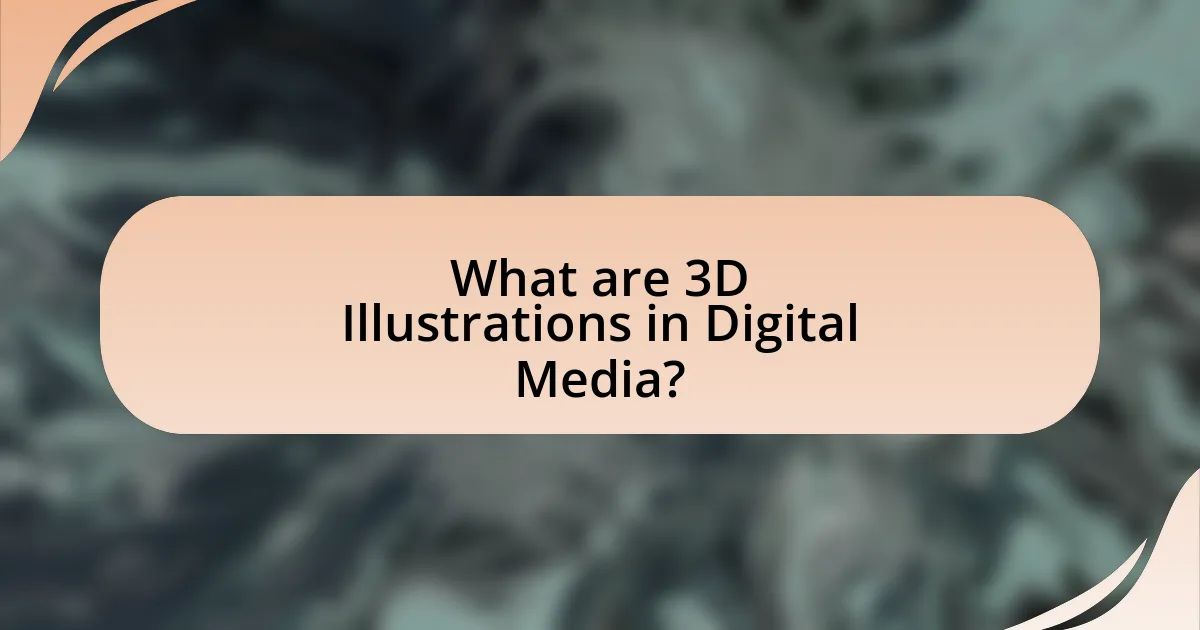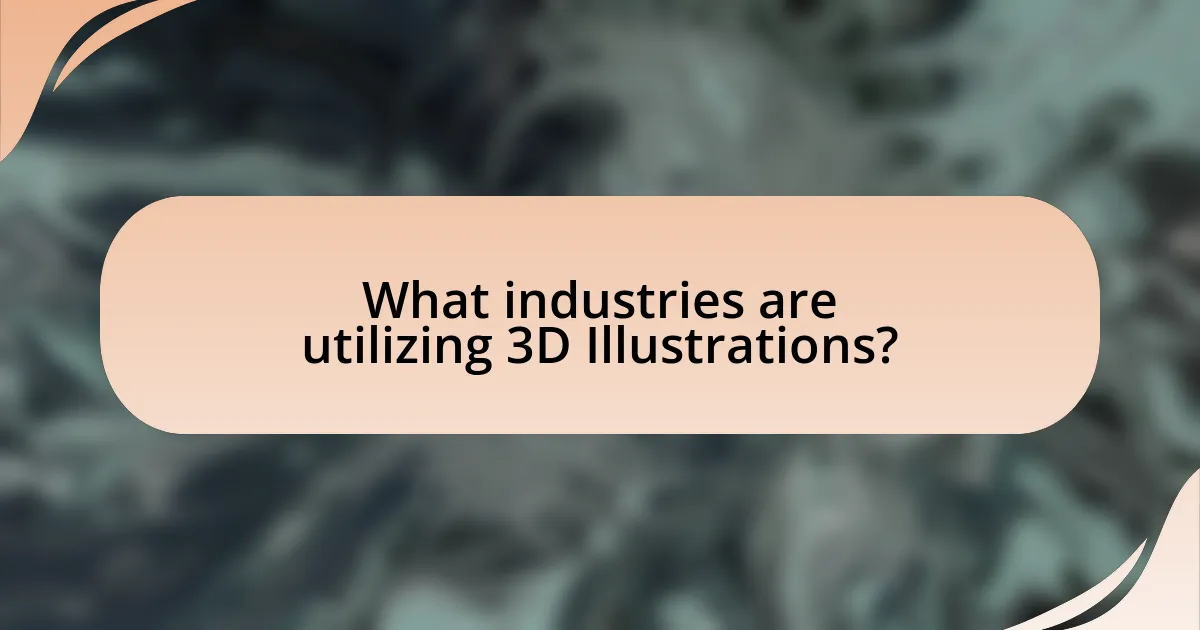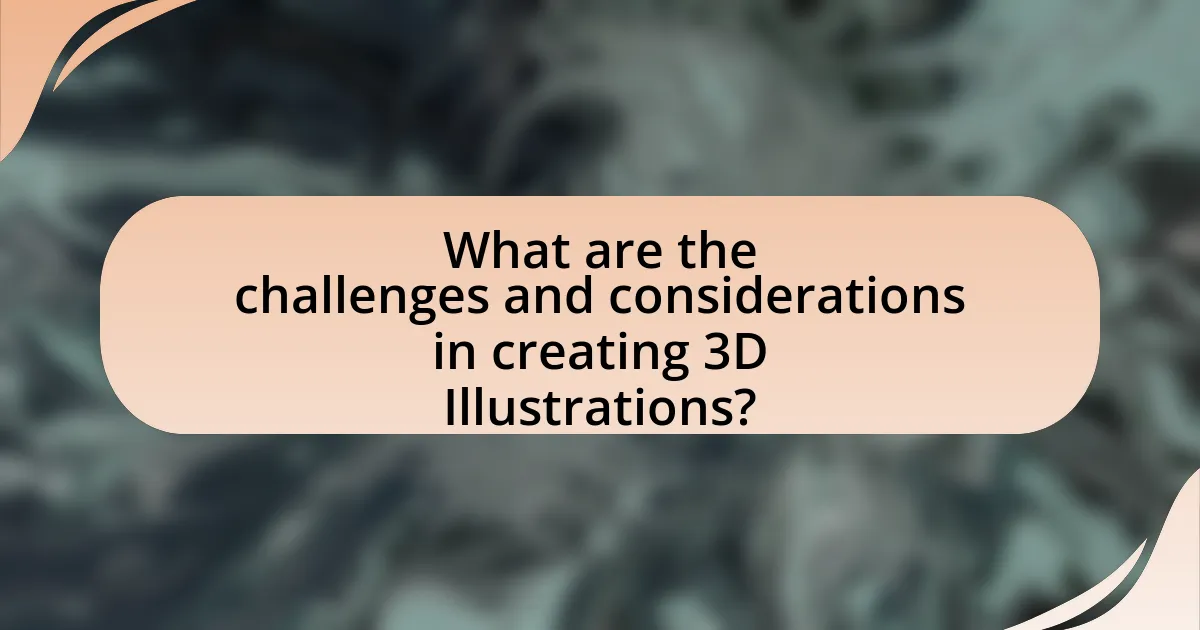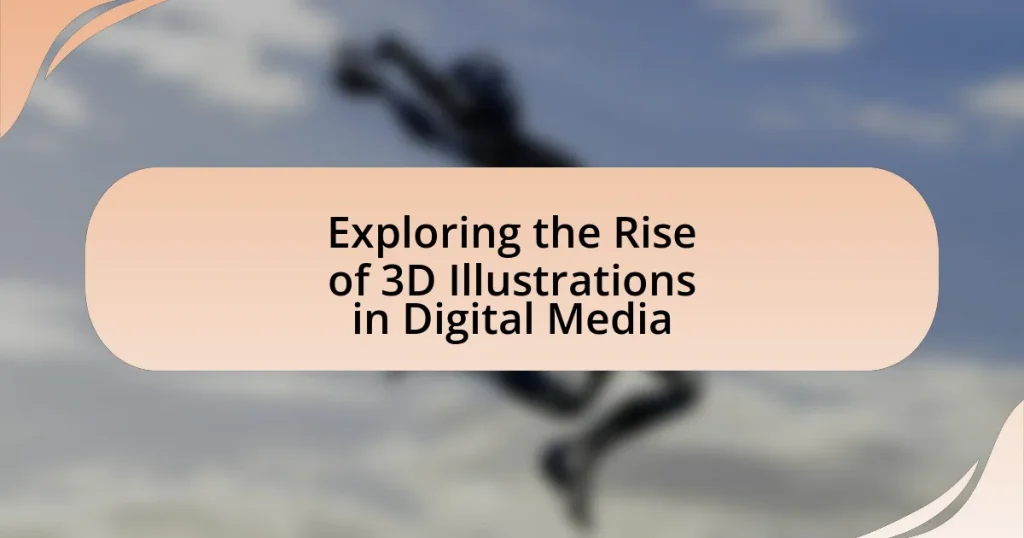3D illustrations in digital media are advanced visual representations created through three-dimensional modeling techniques, offering depth and realism that surpass traditional 2D illustrations. This article explores the evolution of 3D illustrations, highlighting technological advancements that have influenced their rise, such as powerful GPUs and rendering software. It examines the differences between 3D and 2D illustrations, the growing popularity of 3D visuals across various industries including gaming, advertising, and education, and the benefits they provide in enhancing user engagement and comprehension. Additionally, the article addresses the challenges faced by creators, ethical considerations, and best practices for effectively utilizing 3D illustrations in digital content.

What are 3D Illustrations in Digital Media?
3D illustrations in digital media are visual representations created using three-dimensional modeling techniques, allowing for depth and realism that traditional 2D illustrations cannot achieve. These illustrations are commonly utilized in various fields such as advertising, gaming, film, and product design, enhancing visual storytelling and user engagement. The use of software like Blender, Maya, and Cinema 4D facilitates the creation of intricate 3D models, which can be animated and rendered for diverse applications, demonstrating their versatility and effectiveness in modern digital communication.
How have 3D illustrations evolved over time?
3D illustrations have evolved significantly from basic wireframe models in the 1960s to highly detailed and realistic renderings in contemporary digital media. Initially, 3D graphics were limited by computational power and software capabilities, resulting in simplistic shapes and textures. The introduction of rendering techniques like ray tracing in the 1980s improved visual quality, allowing for more realistic lighting and shadows.
In the 1990s, advancements in hardware and software, such as the development of OpenGL and Direct3D, facilitated the creation of complex animations and interactive graphics, which became prevalent in video games and films. The rise of powerful graphics processing units (GPUs) in the 2000s further enhanced the realism of 3D illustrations, enabling artists to create intricate details and lifelike textures.
Today, 3D illustrations incorporate advanced technologies like virtual reality (VR) and augmented reality (AR), allowing for immersive experiences. Software such as Blender, Maya, and ZBrush provides artists with tools to create highly detailed models and animations, reflecting the ongoing evolution of 3D illustration techniques and applications in various fields, including gaming, film, and advertising.
What technological advancements have influenced the rise of 3D illustrations?
Technological advancements such as powerful graphics processing units (GPUs), sophisticated rendering software, and the development of virtual reality (VR) and augmented reality (AR) have significantly influenced the rise of 3D illustrations. The introduction of GPUs has enabled faster and more complex rendering of 3D graphics, allowing artists to create highly detailed and realistic images. Software like Blender and Autodesk Maya has provided tools for modeling, texturing, and animating 3D objects, streamlining the creative process. Additionally, the integration of VR and AR technologies has expanded the applications of 3D illustrations, making them essential in fields like gaming, architecture, and product design. These advancements collectively enhance the capabilities and accessibility of 3D illustration, driving its popularity in digital media.
How do 3D illustrations differ from traditional 2D illustrations?
3D illustrations differ from traditional 2D illustrations primarily in their dimensionality and depth perception. While 2D illustrations are flat and represent images using height and width, 3D illustrations incorporate depth, allowing for a more realistic representation of objects and environments. This dimensionality enables viewers to perceive objects from multiple angles, enhancing the visual experience. Additionally, 3D illustrations often utilize lighting and shadows to create a sense of realism, which is not achievable in standard 2D formats. The use of software like Blender or Maya in 3D illustration allows for intricate modeling and rendering techniques that further distinguish them from 2D illustrations, which typically rely on techniques like shading and perspective to create the illusion of depth.
Why are 3D illustrations gaining popularity in digital media?
3D illustrations are gaining popularity in digital media due to their ability to create immersive and engaging visual experiences. This trend is driven by advancements in technology, such as improved rendering software and increased processing power, which allow for more realistic and detailed graphics. Additionally, the rise of virtual and augmented reality applications has heightened the demand for 3D visuals, as they enhance user interaction and storytelling. According to a report by MarketsandMarkets, the global 3D animation market is expected to grow from $16.2 billion in 2020 to $30.5 billion by 2025, highlighting the increasing reliance on 3D illustrations across various industries, including gaming, advertising, and education.
What advantages do 3D illustrations offer to creators and audiences?
3D illustrations provide enhanced visual engagement for creators and audiences, allowing for more immersive experiences. These illustrations enable creators to convey complex ideas and narratives effectively through realistic representations and dynamic perspectives. For audiences, 3D visuals facilitate better understanding and retention of information, as studies show that people process visual content 60,000 times faster than text. Additionally, 3D illustrations can be easily manipulated and interacted with, offering a level of interactivity that traditional 2D images cannot match, thus increasing audience involvement and satisfaction.
How do 3D illustrations enhance user engagement in digital content?
3D illustrations enhance user engagement in digital content by providing immersive and interactive experiences that capture attention more effectively than traditional 2D visuals. Research indicates that users are 70% more likely to engage with content that includes 3D elements, as these visuals stimulate curiosity and encourage exploration. Additionally, 3D illustrations can convey complex information more clearly, making it easier for users to understand and retain information, which further boosts engagement levels.

What industries are utilizing 3D Illustrations?
Various industries are utilizing 3D illustrations, including gaming, architecture, advertising, healthcare, and education. The gaming industry employs 3D illustrations for character design and immersive environments, while architecture uses them for visualizing buildings and landscapes. Advertising leverages 3D illustrations to create engaging promotional materials, healthcare utilizes them for medical imaging and educational purposes, and the education sector incorporates them to enhance learning experiences through interactive content. These applications demonstrate the versatility and growing importance of 3D illustrations across multiple sectors.
Which sectors are leading the adoption of 3D illustrations?
The sectors leading the adoption of 3D illustrations are primarily the entertainment, gaming, architecture, and healthcare industries. The entertainment sector utilizes 3D illustrations for animated films and visual effects, while the gaming industry relies heavily on 3D graphics for immersive experiences. Architecture employs 3D illustrations for visualizing designs and presentations, and the healthcare sector uses them for medical imaging and educational purposes. According to a report by MarketsandMarkets, the global 3D visualization market is projected to grow significantly, indicating the increasing reliance on 3D illustrations across these sectors.
How are 3D illustrations used in advertising and marketing?
3D illustrations are utilized in advertising and marketing to create visually engaging content that captures consumer attention and enhances brand storytelling. These illustrations allow brands to showcase products in a realistic and interactive manner, facilitating better consumer understanding and engagement. For instance, a study by the Nielsen Norman Group found that 3D product visualizations can increase user engagement by up to 40%, demonstrating their effectiveness in driving consumer interest and purchase intent. Additionally, 3D illustrations can be easily adapted for various platforms, including social media, websites, and virtual reality environments, making them versatile tools in modern marketing strategies.
What role do 3D illustrations play in the gaming industry?
3D illustrations are essential in the gaming industry as they create immersive environments and characters that enhance player engagement. These visual elements allow for realistic graphics, which contribute to the overall gaming experience by providing depth and detail that 2D illustrations cannot achieve. For instance, the use of 3D modeling techniques enables developers to design intricate worlds and lifelike animations, which are crucial for modern gaming. According to a report by Newzoo, 3D graphics significantly impact player retention and satisfaction, with 70% of gamers preferring visually rich experiences. This demonstrates the critical role that 3D illustrations play in attracting and maintaining a dedicated player base.
How are educational institutions incorporating 3D illustrations?
Educational institutions are incorporating 3D illustrations by integrating them into curricula across various subjects, enhancing visual learning and engagement. For instance, universities utilize 3D models in fields like architecture and engineering to provide students with realistic representations of structures and systems. Research indicates that 3D visualizations improve comprehension and retention of complex concepts, as evidenced by a study published in the Journal of Educational Technology & Society, which found that students using 3D models scored significantly higher on assessments compared to those relying solely on 2D images. Additionally, institutions are employing virtual reality (VR) environments that utilize 3D illustrations to simulate real-world scenarios, further enriching the educational experience.
What benefits do 3D illustrations provide in educational content?
3D illustrations enhance educational content by improving engagement, comprehension, and retention of information. Research indicates that visual learning aids, such as 3D models, can increase information retention by up to 65% compared to traditional 2D images. This is because 3D illustrations provide a more immersive experience, allowing learners to visualize complex concepts and interact with the material in a way that promotes deeper understanding. Additionally, studies show that students are more motivated and interested in subjects when they are presented with dynamic visual content, leading to improved academic performance.
How can 3D illustrations improve learning outcomes?
3D illustrations can improve learning outcomes by enhancing visual engagement and comprehension. Research indicates that learners retain information better when it is presented in a visually stimulating format, such as 3D models, compared to traditional 2D images. A study published in the Journal of Educational Psychology found that students who used 3D visualizations scored 30% higher on retention tests than those who relied on 2D representations. This improvement is attributed to the ability of 3D illustrations to provide a more immersive and interactive learning experience, allowing learners to explore complex concepts from multiple angles and perspectives.

What are the challenges and considerations in creating 3D Illustrations?
Creating 3D illustrations involves several challenges and considerations, including technical skill requirements, software limitations, and artistic vision. Technical skills are essential, as artists must be proficient in 3D modeling software like Blender or Maya, which can have steep learning curves. Software limitations can also pose challenges, as not all programs support advanced rendering techniques or may require high computational power, impacting the quality and efficiency of the work. Additionally, artistic vision is crucial; artists must balance realism with creativity, ensuring that the final product meets the intended aesthetic and functional goals. These challenges highlight the complexity of producing effective 3D illustrations in digital media.
What technical skills are required for creating effective 3D illustrations?
Creating effective 3D illustrations requires proficiency in software such as Blender, Maya, or 3ds Max, along with skills in modeling, texturing, lighting, and rendering. Mastery of these technical skills enables artists to create realistic and visually appealing 3D graphics. For instance, modeling involves creating the 3D shapes, while texturing adds surface details, and lighting enhances the overall composition. Rendering is the final step that produces the image or animation from the 3D scene. These skills are essential in the digital media landscape, where high-quality 3D illustrations are increasingly in demand for applications in gaming, film, and advertising.
How can artists overcome common technical challenges in 3D illustration?
Artists can overcome common technical challenges in 3D illustration by utilizing advanced software tools, engaging in continuous learning, and collaborating with peers. Advanced software, such as Blender or Maya, offers features that simplify complex tasks, enabling artists to focus on creativity rather than technical limitations. Continuous learning through online courses or tutorials helps artists stay updated with the latest techniques and tools, enhancing their skill set. Collaboration with peers allows for knowledge sharing and problem-solving, which can lead to innovative solutions for technical issues. These strategies are supported by industry trends showing that artists who invest in skill development and community engagement produce higher-quality work and adapt more effectively to technological advancements.
What software tools are essential for 3D illustration creation?
Essential software tools for 3D illustration creation include Blender, Autodesk Maya, and Cinema 4D. Blender is a free and open-source tool widely used for modeling, animation, and rendering, making it accessible for both beginners and professionals. Autodesk Maya is a comprehensive software favored in the industry for its advanced features in animation and simulation, often used in film and game development. Cinema 4D is known for its user-friendly interface and powerful motion graphics capabilities, making it popular among graphic designers. These tools are validated by their widespread adoption in professional environments, showcasing their effectiveness in producing high-quality 3D illustrations.
What ethical considerations should be taken into account?
Ethical considerations in the rise of 3D illustrations in digital media include issues of copyright, representation, and the potential for misinformation. Copyright concerns arise when artists create 3D illustrations that may inadvertently infringe on existing intellectual property, as seen in cases where designs closely resemble trademarked characters or logos. Representation is crucial, as 3D illustrations can perpetuate stereotypes or exclude diverse perspectives, impacting audience perception and inclusivity. Additionally, the potential for misinformation is significant, as realistic 3D illustrations can be manipulated to create misleading content, which has been documented in various studies highlighting the spread of deepfakes and altered images in media. These considerations necessitate a careful approach to the creation and dissemination of 3D illustrations to uphold ethical standards in digital media.
How can creators ensure authenticity in their 3D illustrations?
Creators can ensure authenticity in their 3D illustrations by incorporating real-world references and utilizing accurate textures and lighting. By studying and replicating the physical properties of materials and environments, creators can achieve a more realistic representation. For instance, using high-resolution photographs for texture mapping and understanding the principles of light behavior can enhance the authenticity of the illustrations. Additionally, engaging with user feedback and iterating on designs based on real-world observations can further validate the authenticity of the work.
What are the implications of copyright in 3D illustrations?
Copyright in 3D illustrations primarily protects the original artistic expression of the creator, granting them exclusive rights to reproduce, distribute, and display their work. This legal framework ensures that artists can control how their 3D illustrations are used, preventing unauthorized reproductions or adaptations that could undermine their economic interests. For instance, under the U.S. Copyright Act, 3D illustrations are considered artistic works, which means they are automatically protected upon creation, provided they meet the originality requirement. This protection extends to both the digital files and the physical representations of the illustrations, reinforcing the creator’s rights in various media.
What are best practices for using 3D illustrations effectively?
Best practices for using 3D illustrations effectively include ensuring clarity, maintaining consistency, and optimizing for performance. Clarity is achieved by using simple shapes and avoiding excessive detail, which helps the audience understand the message quickly. Consistency in style, color, and lighting across all illustrations reinforces brand identity and enhances visual coherence. Optimizing for performance involves reducing file sizes and using appropriate formats to ensure fast loading times, which is crucial for user experience in digital media. These practices are supported by industry standards that emphasize user engagement and accessibility, making 3D illustrations more impactful in conveying information.
How can creators optimize 3D illustrations for different platforms?
Creators can optimize 3D illustrations for different platforms by adjusting file formats, resolution, and interactivity based on the platform’s requirements. For instance, using formats like GLTF or FBX for web applications ensures compatibility and faster loading times, while high-resolution textures are essential for print media. Additionally, creators should consider the platform’s performance capabilities; mobile devices may require lower polygon counts and simplified models to maintain smooth performance. Research indicates that optimizing 3D assets can reduce loading times by up to 70%, enhancing user experience across platforms.
What tips can enhance the visual impact of 3D illustrations?
To enhance the visual impact of 3D illustrations, focus on effective lighting, color contrast, and composition. Effective lighting can create depth and highlight important features, while color contrast draws attention and evokes emotions. Additionally, a well-thought-out composition guides the viewer’s eye and emphasizes the focal points of the illustration. Research indicates that illustrations with strong lighting and color schemes are more engaging, as they align with principles of visual perception, making the artwork more memorable and impactful.


